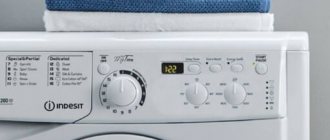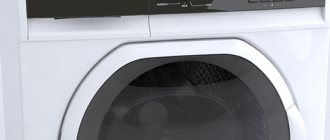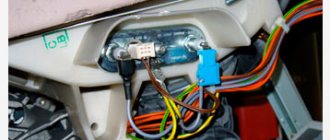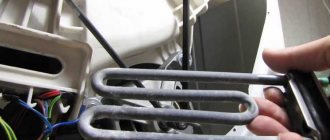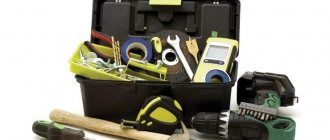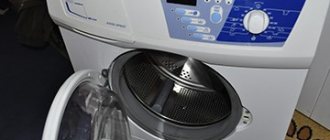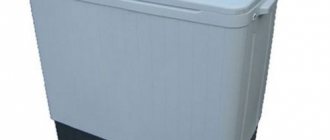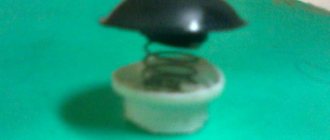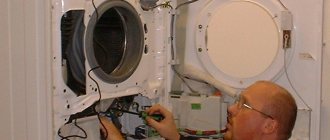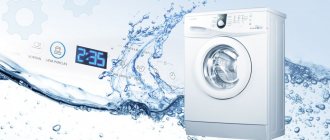- We disassemble the washing machine
Household appliances tend to break down when you least expect it. Bosch washing machines are no exception. That is why many are interested in whether it is possible to repair a Bosch washing machine with your own hands, without the help of a specialist. Experts answer this question in the affirmative. To dismantle, inspect and replace parts, you must have instructions, a diagram of the washing machine and a certain set of tools.
Even a novice technician can repair a washing machine at home.
Diagnostics of breakdowns
Modern Bosch washing machines contain a special program that allows you to identify faults without asking a technician for help.
The operating instructions for your Bosch washing machine should contain information on how to perform such diagnostics. If the drum stops rotating, then you need to perform the following sequence of actions:
- Close the door;
- Set the program selection knob to the “Off” position;
- Wait a couple of seconds;
- The spin handle should be set to the “Spin” position;
- Next, wait until the “Start” button starts flashing;
- Keep the “Spin speed” button pressed;
- Wait until the “Start” button flashes again;
- Set the handle to the “Drain” mode;
- Release the “Spin speed” button;
- Determine the latest failure using the error code for the Bosch washing machine.
The program deletes the last error from memory and runs diagnostics. To check the electric motor, set the mode selection knob to position 3.
To check the drain pump, set the handle to position 4. You can check the heating element by setting position 5. Diagnostics of the hot or cold water inlet valves is carried out when selecting positions 6 and 7. When choosing position 8, the water inlet valve is tested during the main wash, and 9 - during the preliminary wash washing.
Incorrect operation of the machine
Housewives themselves are often unwittingly to blame for the occurrence of malfunctions. We didn’t read the instructions carefully, didn’t study enough the features of each program - and now our favorite washing machine simply froze in the middle of the cycle! If the cause of the breakdown really lies in improper operation, then the car will be able to be revived independently.
Failure to comply with washing machine loading standards, overload by weight
The most common reason for a washing machine stopping during operation is its overload. The desire to save time, water, and electricity forces some housewives to put a huge amount of things into the drum. You can “deceive” the equipment by adding several thin T-shirts to the already loaded 4-5 kg of laundry. In such a situation, the laundry simply doesn’t wash well. But sometimes the weight of the laundry exceeds the permissible limit several times!
If the machine is overloaded, this is detected already at the beginning of the cycle. Modern models have special sensors that immediately determine the weight of the laundry and, if overloaded, give an audible signal. In machines of previous generations, the drum rotates very slowly, as if through force. And soon the washing machine stops completely during washing.
The solution to the overload problem is simple - just remove a few things and start the cycle again. In the future, you should fill the drum no more than 2/3 of its volume. You can also use a household steelyard to weigh dirty laundry.
Incorrect program selection
The machine may stop while washing on delicate cycles. In this case, it may turn out that the drum is half filled with water. Common situation? Do not panic, try to open the door or randomly press buttons. Most likely, in the delicate or manual mode used, spinning is simply not provided. In this case, you need to independently set the water removal mode, and, if necessary, spin.
Imbalance
Another reason for the machine to stop working normally is the uneven distribution of things in the drum. This can happen with bed linen - it absorbs all the water, crumples in the lower part of the drum, thus preventing it from making a full turn. The situation can arise not only at the main wash stage, but also during the spin cycle. Stopping is often preceded by a dull knock or vibration.
What to do in such a situation? It is necessary to open the loading hatch and use your hands to evenly distribute the items in the drum. After a minute, continue washing on the set mode.
An imbalance of items can occur when washing a down jacket or bulky bologna pants. The filler collects water at the bottom of the drum and the machine stops working. In such a situation, it is worth using a proven folk method - washing the down jacket along with the tennis balls.
Program control failure
The washing machine may also turn off due to program failures. For example, if the washing process consists of several steps. When the soaking and main wash modes are set, the intelligent equipment will stop after the first stage. The second part of the wash will have to be installed again.
Sometimes equipment can freeze for no apparent reason. This should also be regarded as a software glitch. In this case, you just need to reboot it:
- press the off button, wait a minute and turn the machine on again;
- if disconnecting from the button does not save the situation, then you need to disconnect the machine from the network;
- after a few minutes the machine turns on and the cycle starts again.
Most common faults
According to Bosch service center technicians, the most common breakdowns are:
- During washing, the water does not heat up;
- Water does not drain;
- The drum does not rotate;
- The washing machine drum makes noise;
- Water does not fill;
- The electric motor does not start.
When analyzing faults, we can come to the conclusion that in Bosch washing machines the heating element most often fails. If the heating element is broken and the electronic system is working properly, the repair will not take much time.
However, if the electronic system also fails, then repairs will be quite expensive. After all, you will have to replace electronic modules and call a technician.
Service test Bosch Maxx 4
During the operation of German Bosch machines, malfunctions occur less frequently than with competitors; however, the manufacturer has equipped each Bosch Maxx model with a special service test, the so-called self-diagnosis mode, which can determine the performance of all system functions. This function is very useful if several system components are broken.
Launching the diagnostic mode is performed differently depending on the line: Bosch Maxx 4, Bosch Maxx 5, Bosch classixx 5, etc.
Let's look at the test using the Bosch Maxx 4 series as an example.
To start self-diagnosis of Bosch Maxx 4, turn off the machine. Simultaneously press the additional function buttons and turn the mode knob 30° clap. After a successful launch, you can begin selecting a test.
Bosch Maxx 4 programs comply with the following tests:
- cotton 60° - check the electric motor;
- cotton 60° economy - drain pump;
- cotton 90° - heater;
- spin - main valve;
- drain - pre-valve.
To start the program on Bosch Maxx 4, press the “start” button. Faults are indicated by combinations of LEDs. In older Bosch Max models, error codes are displayed.
Causes of breakdowns
There are a number of reasons why a Bosch washing machine may fail. Let's look at them one by one.
It may not drain at the end of the wash cycle for one of the following reasons:
- Pump or drain filter clogged;
- Poor contact between power supply and pump;
- The drain pump is faulty;
- The water level sensor is broken.
The drum stop may occur for the following reasons:
- The drive belt has worn out;
- Faulty control board or electronics;
- Failure of the electric motor (rare case).
The drum may make noise when operating. This may be due to the following reasons:
- The bearings are out of order;
- Small objects are stuck in the drum;
- The shock absorber is broken;
- Problems with counterweight.
It is possible that water does not fill into the tank. In this case, the following reasons are distinguished:
- The Aquastop system or pump is clogged;
- Lack of water in the water supply;
- Kink in the drain hose.
If the electric motor does not start, then most likely the drum hatch door is not closed or the electronics have failed. Once the cause of the problem has been identified, repairs can begin.
Error codes
Error codes usually appear when one of the system elements fails. A DIYer can save time and money by quickly identifying the error using these codes.
Machines of the Bosch Maxx 4, Bosch Classixx 5, Bosch Maxx 6 series or the Bosch Classixx washing machine indicate incorrect operation with the following symbols:
- F16 - when starting programs, the laundry loading hole is open.
- F17 - exceeding the specified time for water entering the system. The reasons are clogged valves and filters, a closed water supply valve to the system.
- F18 - water drain time has expired. The drain valve may be clogged or the water level sensor may be faulty.
- F19 - the standard water heating time for the washing machine has expired. Typical reasons are low voltage in the network, failure of the heating element or thermostat.
- F20 - no water heating. The thermostat or heating element may fail.
- F21 - drum failure. The breakdown occurs due to a broken relay or tachogenerator reverse.
- F22 - malfunction of the NTC sensor. Associated with a short circuit and breaks in the electrical wiring circuit.
- F23 - activation of the Aquastop system. There is liquid in the pan and there is a break in the electrical circuit.
- F25 - turbidity sensor error.
- F26 - malfunction of the analog sensor.
- F27 - flow switch malfunction.
- F28 - failure of the fluid pressure sensor.
- F29 - incorrect operation of the motor.
- F30 - no engine rotation.
- F40 - violation of synchronization of electrical equipment. The reason is the discrepancy between the local electrical network and the required technical characteristics of the machines.
- F50 - low or high flow rate.
- F51 - door error.
- F53 - functional protection failure.
- F54 - malfunction of the control module.
- F63 - control module error.
Drain filter repair
The drain filter is located at the bottom of the machine, under the lid or panel. To clean the filter, open the cover. To do this, turn it counterclockwise. Filter - wash and install in its original place.
To clean or replace the drain pump, you need to remove the front cover of the Bosch washing machine. This work is labor-intensive, but not difficult.
Quite often there is a malfunction in which water does not fill into the Bosch washing machine. In this case, it is necessary to check the water supply and the water supply valve. They may be closed. Next, check whether there are any kinks in the drain hose. If everything is in order, check the condition of Aquastop. If this element of the Bosch washing machine fails, it should be replaced with a new one.
If the water level sensor breaks down, it must be replaced. To do this, first remove the top cover by unscrewing the two screws located at the back. This sensor should be located in the right corner under the cover. To remove the water level sensor, you need to press the latch. Next, remove the hose and disconnect the contacts. A new sensor is installed in place of the old sensor.
Error codes for Bosch Maxx washing machines 5,6,7.
Let's start with error codes for Bosch Maxx 5,6,7 washing machines. The table below shows the main errors of the Bosch washing machine, which are available to the user in the event of a malfunction. Error codes for Bosch Maxx 5,6,7 washing machines are displayed in the normal washing mode, so the user can identify the malfunction of his machine. Fault codes are displayed on the display, and if it is absent, they are read by the combination of blinking spin indicators. Both options are in the table.
| Code on display | Code without display, read by spin speed indicator | Description of the error | Cause and elimination |
| F16 | The laundry hatch is not closed | Close the hatch more tightly and restart the mode. | |
| F17 | The water filling time has been exceeded. | Check: if the tap is open; Is the inlet hose filter clogged? The pressure in the water supply may be too low. | |
| F18 | Draining takes too long. | We check: whether the drain pump is working (working resistance of the winding is 170-200 Ohms); is there a blockage in the filter and drain hose; serviceability of the level sensor (pressure switch); serviceability or blockage of the rubber hose of the pressure switch. | |
| F19 | Heating up too long. | Check: is the heating element in good working order (operating resistance 25-30 Ohms); voltage in the electrical network (must be at least 200 V); heating element wiring and connections. | |
| F20 | Heating does not occur according to program. | Out of order: NTC temperature sensor; relay for turning on the heating element on the board. | |
| F21 | The problem is in the engine control system, the engine does not rotate the drum. | The serviceability is checked: tacho sensor; triac on the control board; motor reverse relay on the board. | |
| F22 | The NTC temperature sensor is faulty. | We check: the NTC sensor, if it is closed or broken, then replace it; NTC wiring and terminals. | |
| F23 | AQUA STOP triggered and a leak occurred. | Water has accumulated in the pan, a leak has occurred, we check: The tightness of the tank and MAS pipes; Aqua Stop sensor and its wiring. | |
| F40 | The network voltage is not normal. | We check the voltage in the electrical network, operating voltage 220 V | |
| F63 | Software malfunction. | Checking: memory firmware; board processor. If necessary, we change the board. |
Replacing the heating element
You can replace the heating element of a Bosch washing machine yourself. To do this, you need to remove the back cover of the Bosch washing machine. The heating element is located below, under the tank. To replace the heating element, you must perform the following steps:
- Unscrew the bolt that secures the heating element to the tank.
- Disconnect the wires;
- Dismantle the heating element;
- Install a new heating element and perform all steps in reverse order.
Repairing a Bosch automatic washing machine: getting to the equipment yourself
You can fix the malfunctions from our list below with your own hands, provided that you pay close attention to the process of assembling and disassembling the device and correctly perform replacement or other manipulation regarding the internal equipment.
The drain pump has failed: how to replace it
Before disassembling the device, be sure to drain the water from it, otherwise you will wet all the parts in the machine. To get to the drain pump of the machine, you need to disassemble the back and top wall of the housing of the household appliance. Then turn the car on its side, having first secured the drum with bolts. Then remove the pump by disconnecting the terminals. After the manipulation has been done, we take a new structure suitable for this model of machine and securely fix it in its original place.
Repairing a bearing yourself: stages of the procedure
The bearing in the washing machine is responsible for the correct operation of the drum; if it wears out, it must be replaced so as not to damage the drum itself. To do this, follow the algorithm:
- We remove the body from the washing machine, remove excess water and debris from the tank.
- The difficulty is that you need to disconnect all the panels, the powder dispenser, remove the door clamp and cuff, and pull out the lock.
- Once these steps have been completed, we proceed to detach the tank. To do this, remove all the fixing bolts.
- The drive belt should be pulled to the side to avoid accidentally damaging it.
- Unscrew all the bolts that hold the plastic tank and remove it from the springs.
- Having reached the metal part of the drum, remove the pulley and existing bolts from it.
- A metal bearing is installed on the back of the drum.
- Knock out the damaged part and install a new one, performing all the steps exactly the opposite.
Good to know! In order not to confuse all the connections during assembly, it is best to photograph complex stages of work. Thus, you will be able to design a washing machine without errors.
How to remove and change the drive belt on a Bosch washing machine
Replacing the drive belt is carried out within a few minutes, so this work is considered elementary. All you need to do is remove all the screws on the rear convex cover. Opening it, you will see the motor drive and the drum along which the belt moves.
To remove it, you need to carefully pull it away from the parts, slightly turning the drum wheel. Put on the new belt in the same way. For clarity, watch this short video.
Heating element replacement procedure
If the water in the washing machine tank is cold and does not heat up during the operation of the device, this indicates that the laundry is unlikely to be washed. If you look inside the problem, then the damage to the heating element is to blame. To extract it, consider the following short instruction.
| Illustration | Description of action |
| Unscrew the fixing bolts and remove the top surface of the washing machine. | |
| Remove the detergent dispenser. To do this, just press the button located in the middle of the tray. | |
| To remove the front panel, you need to unscrew 4 screws, as shown in the photo. | |
| Remove the front panel by unscrewing all the fastening screws, and at the bottom of the drum you will see the attached heating element. Remove all contacts from it. | |
| Having unscrewed the nut of the heating element, we take out the part and install a new heating element in its place in the same way. Then we assemble the washing machine. |
As you can see, disassembling a Bosch washing machine to replace the heater is a very lengthy and painstaking job, so you should pay close attention to all the points.
How to clear a clogged drain hose when repairing a Bosh washing machine at home
During the long operation of the automatic machine, you may have noticed that when you turn on the water does not enter the tank as quickly as it did initially. If this is not a problem with your water supply pressure, then the water supply hose filter is clogged.
In order to clean it, you need to unfasten the tube on the back of the machine body. Remove the mesh that is placed inside the hose and screwed on using a thread. Rinse it well under running water and dry. Then install it in place and enjoy excellent water pressure.
Electrical or electronic malfunction
Not being a specialist in the field of electronics or electrics of automatic washing machines, it is better to contact a service center that will carry out diagnostics and necessary repairs. You can learn more about the nuances of repairing this part of the device from the video below.
Replacing the drive belt and bearings
Replacing bearings on Bosch washing equipment is quite a difficult task, since this will require disassembling almost the entire washing machine. Watch a video on how to replace bearings:
The electric motor may stop due to wear on the drive belt. You can replace this element yourself. To do this, you need to perform the following sequence of actions:
- Open the back cover of the Bosch washing machine;
- Remember how the belt is secured to the grooves of the pulley. It's better to take a photo of this element.
- Take the belt slightly below the pulley and gently pull it towards you.
- With your free hand, turn the pulley counterclockwise.
- Remove the old belt from the washing machine body.
- Place a new belt on the Bosch washing machine motor.
- Pull the belt with one hand, and with the other try to put the drive belt on the pulley.
- Turn the pulley counterclockwise without loosening the belt. In this case, you must try to put the belt on completely.
- Install the body cover of the Bosch washing machine.
Preparing for work
Carrying out absolutely any work is not complete without a preparatory stage. In the case of disassembling a branded Bosh washing machine, the first thing a home craftsman will need to do is find out all the information regarding its structure and design. Having a clear idea of where this or that part is located, dismantling work is much easier and faster.
Before disassembling the washing machine, you need to prepare a number of necessary tools. It is advisable that you have them at hand during the work process, so that at the right time you do not have to look for the required device, wasting time. To disassemble the device, a home craftsman will need:
- wrenches - wrenches and adjustable ones, of different sizes (ideally, it is recommended to have a whole set of wrenches);
- hammer - it is advisable to prepare several hammers of different sizes (which one will be needed for dismantling work will depend on the specific type of malfunction that has arisen and the modification of the unit);
- screwdrivers - since the design of current machines includes components fixed with different screws, you will need to use several types of screwdrivers, namely: hex, Phillips, straight slot;
- pliers;
- hammer.
The unit will need to be pulled out into a free space where there will be no interference. People often disassemble cars in a garage or workshop, but not all users have this opportunity. If you can only disassemble household appliances at home, you will need to first clear the free space so that all planned work can be carried out comfortably.
How to eliminate noise in a car drum
Noise in the drum may occur due to wear of shock absorbers, bearings and a torn counterweight.
Before replacing shock absorbers, you need to carefully examine the drum of your Bosch washing machine using a flashlight. There is probably a small object stuck in it that makes noise when the drum rotates. You can learn how to replace shock absorbers in a washing machine from the following video:
The noise can also be caused by loose counterweights, which are located at the bottom of the Bosch washing machine and under the top cover. To eliminate this malfunction, you need to tighten the counterweight fasteners.
If it is not possible to secure the counterweight, it is recommended to replace it with a similar one. This failure is quite rare.
INSTALLATION
2.1. Installation
For perfect operation, the appliances must be leveled using the feet. If the device is installed on a plinth, for safety reasons the device must be fixed using the fastening kit No. 080451. If the device is installed under a work surface, then a special metal sheet must be installed instead of the top cover of the device.
2.2. Bay of water
Make sure there is a connection to a central water supply (3/4 inch). The optimal water pressure in the water supply should be in the range of 100-1000 kPa (1 to 10 Bar). The water flow from an open tap should be at least 8 l/minute. For pressures >10 bar, a reducer must be installed.
2.2.1. Version with Aqua Stop valve (optional)
Aqua-Stop is supplied with a hose approximately 1.5 m long. The hose can be extended to 2.5 m with the original extension pipe WZ10130 / WMZ2380 or a longer hose with Aqua-Stop (purchase from service no. 665053, 310 cm). The valve can only be installed as shown in the figure. It cannot be placed in water, however it can be placed in an area with protection class 1 if the device is connected via a 30 mA RCD. The outlet must be in an area with protection class 3 or higher.
Rice. 2
Aqua-Stop comes with a hose
2.2.2 Hot water (optional)
Appliances that operate with hot tap water are equipped with two valves. The hot water valve is marked in red; the water temperature should not exceed 60°C.
2.3. Draining
The length of the drain hose can be increased to 4 m (432060 2.20 m), but only if the hose is lying on the floor and has no more than one connection. Devices without Aqua-Stop do not have a container return. The drain hose must not be installed lower than 60 cm.
2.4. Electrical connection
The device can only be connected to a grounded socket. Observe the parameters on the nameplate. The residual current circuit breaker must be rated at 10 A. Connection cable 3 m long (with a grounded plug): no: 481580.
| A | 115 – 150 cm | E | 70 cm |
| B | 175 – 200 cm | F | 130 cm |
| C | 200 cm | G | min. 60 cm |
| D | 145 cm | H | max. 100 cm |
Rice. 3
Connecting the machine to communications
Troubleshooting engine and electronics
There are two ways to resolve this problem. The essence of the first method is that the electric motor of the Bosch washing machine needs to be removed and sent to repairmen. They may be able to fix the problem. If the engine cannot be repaired, it will need to be replaced. Such a replacement will be quite expensive.
In order to get to the Bosch washing machine motor, you need to remove the back wall of the washing machine. The engine is located under the tank. First you need to disconnect the wires and sensor from the motor. Secure the engine with three fasteners. They need to be unscrewed. Experts advise checking the serviceability of the sensor condensate before removing the motor. For these purposes you will need a multimeter. It is necessary to connect the probes of the device to the contacts and look at its indicators. The multimeter should show 20-50 ohms.
If you suspect that the wiring is faulty, you need to check all terminals, contacts and plugs.
If the control unit fails, you need to call a technician or dismantle the part and take it to a Bosch service center. You should not try to repair the electronics of German technology. After all, to perform such work you need to know many subtleties.
General recommendations
Today, Bosch washing machines are considered one of the most popular and in demand. The well-known brand has long conquered the market, so in many homes you can find household appliances made by it. If you plan to disassemble a Bosch machine yourself at home, you should arm yourself with some useful tips and tricks.
You need to be especially careful when removing the control panel of Bosch machines. Short bundles of wires stretch to this part. If you pull the parts too hard, they will simply break.
Do not attempt to disassemble branded equipment with your own hands if the described instructions frighten you. If you are afraid of making a serious mistake when assembling or disassembling the machine, it is better to entrust all work to service workers or experienced repairmen. If the device is still under warranty, you cannot repair it yourself - you must go to a Bosch service center, otherwise you will lose warranty service.
You can see some of the features of disassembling a Bosch washing machine in the following video.
Preventive Maintenance
Complex mechanical devices cannot work forever, but it is possible to delay their breakdown. To do this, you must comply with the technical operating conditions and carry out preventive measures:
- After completing the wash, the door must be left open and the rubber seal wiped dry.
- Clean the drain filter regularly.
- To clean the heating element, periodically run a wash cycle without clothes, but with anti-scale agent.
- The electrical part of the Bosh machine, although made reliably, does not like voltage surges. If the electrical network is of poor quality. It's better to use a stabilizer.
Useful tips Connection diagrams Principles of operation of devices Main concepts Meters from Energomer Precautions Incandescent lamps Video instructions for the master Testing with a multimeter

